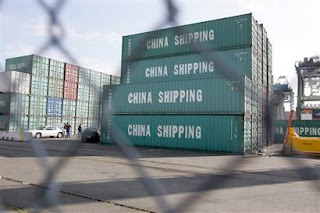BDI Recovering - All Eyes on China
 Visit the front page of Wall Street Greek to see our current coverage of economic reports and financial markets.
Visit the front page of Wall Street Greek to see our current coverage of economic reports and financial markets.(Tickers: SEA, EGLE, GNK, DSX, NAT, SINO, PRGN, XSEAX, DIA, SPY, QQQQ, NYX, DOG, SDS, QLD, XLF, IWM, TWM, IWD, SDK)
Miral Shipping Freight Market Report
Authored July 15, 2009
 Independent Shipbroker & Consultant to commodities traders, Alexander Miral offers Wall Street Greek readers a timely take on the Shipping Freight Market.
Independent Shipbroker & Consultant to commodities traders, Alexander Miral offers Wall Street Greek readers a timely take on the Shipping Freight Market.BDI Recovering After Recent Slump
During the past three weeks, the Baltic Dry Index fell to 2975 points or just over 30 percent, and now has risen back to 3324. Most of the drop in rates was in the capesize sector (over 100,000 tons deadweight), which has fallen to 4788, or approximately 40%, but has now recovered to 5549. Other vessel classes have been less volatile; the panamax ship index (over 60,000 dwt) went slightly negative to 2955, less than 5 percent, before turning positive and closing today at 3141; the supramax index (50,000 dwt) stood at 1953 and handysize (below 40,000 dwt) just over 800. Both vessel indexes have posted slight gains of approximately 5 percent.
Much has happened in this time. Iron Ore shipments to China seem to have slowed amidst difficult talks going on between Australian iron ore suppliers and Chinese buyers. The Chinese are still fighting for more than the 33% price reduction agreed to with other Asian steel producers. Negotiations are such that three workers of Rio Tinto were detained in Shanghai by the Chinese authorities for espionage and bribery!
Panamax, Supramax and handysize vessels all have benefited from healthy amounts of grain, fertilizer and coal currently being shipped. The main areas of strength continue to be out of East Coast South America and the US Gulf to both Atlantic and Far East destinations.
Going forward, all eyes are on China, which continues to show signs of strength. Chinese GDP growth appears to be headed for 8% for 2009, a remarkable achievement. Fixed investment and retail sales have shown large gains in May. Furthermore, the Chinese auto sector alone was recently reported to have grown by more than 48% year-over-year in June. Exports are also showing stabilization and even a slight rise after falling considerably earlier this year.
Certainly a substantial part of this growth is related to Chinese government stimulus packages and incentives, and there are doubts about how much underlying demand there would be without the stimulus. Nevertheless, it appears as though the Chinese authorities will continue to support growth of 8% or more, a positive for the global freight market. The expected supply of new vessels later this year may be a negative factor, depending mainly on whether Chinese demand continues.
Technically, the Baltic Freight Index is looking for support, and the situation is different for every vessel class. The Capesize market shows major support at the $40,000 TC average and appeared to be headed that way, but it found support yesterday (at least temporarily) at approximately $53,000 and has already risen 10% from there. It could now rise to over $70,000 TCE before hitting major resistance.
The Panamax index, which stands now at a more historically average differential to the capsize market, has been in a technical triangle for nearly two months, but appears to be breaking the pattern on the upside and could move up another 10% before finding resistance. Supramaxes are close to resistance on the upside and could break out shortly, in my view. Handysizes have approximately 10% more upside before major resistance.
Also interesting to note: the Baltic Exchange is changing the way it will calculate the Baltic Dry index (BDI). It will only use timecharter rates to calculate the Capesize, Panamax, Supramax and Handysize indexes, and will no longer use voyage rates. These changes are meant to facilitate derivative trading, and we will keep a close eye on its effect on the BDI.
 Please see our disclosures at the Wall Street Greek website and author bio pages found there.
Please see our disclosures at the Wall Street Greek website and author bio pages found there.
Labels: Miral, Shipping Market











0 Comments:
Post a Comment
<< Home